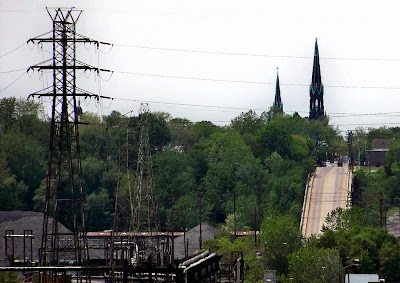 View from the Cleveland's east side, Pershing Avenue
View from the Cleveland's east side, Pershing AvenueDriving along several of the main roads, freeways and bridges in Cleveland one notices the uneven twin steeples of Saint Michael Archangel. As a landmark, outside the concrete, steel and glass knot of skyscrapers of downtown, the only competitor in recognisability is St. Theodosius's, but in number of vantage points, no — it is Saint Michael's.


Right now, the disparity in height has been reduced. The cross is not there. It is temporarily inside the church, and it is something to see and look at in a manner which is not normally available to non-avian creatures. The verde-gris is not a metal patina. The cross is wooden and slotted into the spire.

The church was completed in 1892 in romantic, grand eloquent, high gothic, triumphal revival. The then buff, now black, sandstone exterior came from Berea, which borders Cleveland. The presbyterian church, of the founders of the city, on Public Square was just as black with years of soot accumulation, until sandblasting. The soot patina, actually, is more impressive than the original hue.
The founding pastor, or rector, (1883-1911) was a czech immigrant from the Austrian empire, Joseph Maria Koudelka. He had been the first pastor at the czech parish, Saint Procop (now suppressed by Bp. Lennon), previously from 1875. In 1903 he was also the founding pastor of the slovak parish, Saint Wendelin (scheduled for suppression this May, by Lennon). In 1908 he was ordained the first auxiliary bishop of Cleveland, the titular bishop of Germanicopolis in partibus infidelium, by Bishop Ignatius Horstmann. Koudelka was the first auxiliary in the United States to be given a specific pastoral duty, which was — care of the slavonic peoples in the diocese. This was a cause of discontent among the irish priests in the diocese, and it took four years to finally occur. The irish considered the germans 'foreigners', and themselves 'americans'. Horstmann was born in distant Philadelphia, Pennsylvania, and Koudelka was a slav. Most of the irish (all from Cleveland and Toledo) stayed away from his ordination, and none signed the book of witness. Bishop Horstmann would die three months later from complications of heart attack after the burials of the Collinwood school fire.
Michael's was one of the two, magnificent, german, west side churches. It was, when built, the largest, costliest and most significant church in the diocese. In 1948 it ceased to be a german parish, and had been converted to a territorial parish. It is now mostly, spanish american in attendance. There are now a few new world icons in addition to the earlier religious art. It is a catholic church. This german church had, and has, statues of the polish Stanislaus Kostka and Louis the King of France. Now it is graced with new world Madonnas. All this forms a handsome package of devotions, history, culture, theology and art in wood, glass, paint, and stone. With the morning sun, Michael's is brilliant, solemn, joyful, calm and inspiring, when one is alone with the Divine Presence in the tabernacle it is a portion of serenity.
No comments:
Post a Comment